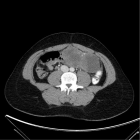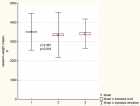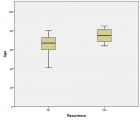Abstract
Research Article
Endometrial thickness and frozen thaw embryo transfer: A prospective study
Mahalakshmi S, Sakthi A, Saravanan L and Sharma Nidhi*
Published: 14 October, 2020 | Volume 3 - Issue 2 | Pages: 132-135
Aim and objectives: Endometrial Window of Implantation (WOI) is open in the midsecretory phase wherein the markers of invasion and cell adhesion are manifested .The primary objective was to find out the predictive value of Endometrial thickness and profile as a prognostic factors for embryo transfers during ART.
Materials and Methods: Endometrial thickness assessment was performed with grey scale ultrasound on the day of transfer just before thawing the embryos in patients undergoing Frozen embryo transfer cycle after endometrial preparation.
Results: The mean age and standard deviation of study population was is 33.26+5.95.Out of 69 patients there was clinical pregnancy in 33 patients , miscarriage in 10 patients and ongoing pregnacy in 23 patients. So the implantation rate was 47.83% (33/69), early miscarriage rate (pregnancy ending before 12 weeks) was 14.49%(10/69) and the ongoing pregnancy rate was 33.33% (23/69). Endometrial thickness < 6 mm had comparable implantation rates but low ongoing pregnancy rates.
Conclusion: The ultrasound morphological and vascular grading of endometrial thickness and vascularity is useful to synchronise Day 5 embryo transfer and window and implantation thereby minimizing the loss of good embryos in nonreceptive endometrium.
Read Full Article HTML DOI: 10.29328/journal.cjog.1001066 Cite this Article Read Full Article PDF
Keywords:
Endometrium; in vitro fertilisation; Implantation, Embryo
References
- Cha J, Vilella F, Dey SK, Simon C. Molecular interplay in successful implantation in ten crtical topics in reproductive medicine 2013; 44-48.
- Cervello I, Gil-Sancis C, Mas A, Delgado-Rosas F, Martinez-Conjero JA, et al. Human endometrial side population cells exhibit genotypic, phenotypic and functional features of somatic stem cells. PloS One. 2010; 5: e10964. https://pubmed.ncbi.nlm.nih.gov/20585575/
- Gellersen B, Brosens IA, Brosens JJ. Decidualization of human endometrium: mechanisma, functions and clinical perspectives. Semin Reprod Med. 2007; 25: 443-453. https://pubmed.ncbi.nlm.nih.gov/17960529/
- Barker MA, Boehnlein LM, Kovacs P, Lindheim SR. Follicular and luteal phase endometrial thickness and echogenic pattern and pregnancy outcome in oocyte donation cycles. J Assist Reprod Genet. 2009; 26: 243-249. https://pubmed.ncbi.nlm.nih.gov/19548081/
- El-Toukhy T, Coomarasamy A, Khairy M, Sunkara K, Seed P, et al. The relationship between endometrial thickness and outcome of medicated frozen embryo replacement cycles. Fertil Steril. 2008; 89: 832-839. https://pubmed.ncbi.nlm.nih.gov/17681313/
- Kumbak B, Erden HF, Tosun S, Akbas H, Ulug U, et al. Outcome of assisted reproduction treatment in patients with endometrial thickness less than 7 mm. Reprod Biomed Online. 2009; 18: 79-84. https://pubmed.ncbi.nlm.nih.gov/19146773/
- Rinaldi L, Lisi F, Floccari A, Lisi R, Pepe G, Fishel S. Endometrial thickness as a predictor of pregnancy after in-vitro fertilization but not after intracytoplasmic sperm injection. Hum Reprod. 1996; 11: 1538-1541. https://pubmed.ncbi.nlm.nih.gov/8671501/
- Kovacs P, Matyas S, Boda K, Kaali SG. The effect of endometrial thickness on IVF/ICSI outcome. Hum Reprod. 2003; 18: 2337-2341. https://pubmed.ncbi.nlm.nih.gov/14585884/
- Zhang X, Chen CH, Confino E, Barnes R, Milad M, et al. Increased endometrial thickness is associated with improved treatment outcome for selected patients undergoing in vitro fertilization-embryo transfer. Fertil Steril. 2005; 83: 336-340. https://pubmed.ncbi.nlm.nih.gov/15705371/
- Richter KS, Bugge KR, Bromer JG, Levy MJ. Relationship between endometrial thickness and embryo implantation, based on 1,294 cycles of in vitro fertilization with transfer of two blastocyst-stage embryos. Fertil Steril. 2007; 87: 53-59. https://pubmed.ncbi.nlm.nih.gov/17081537/
- Shapiro H, Cowell C, Casper RF. The use of vaginal ultrasound for monitoring endometrial preparation in a donor oocyte program. Fertil Steril. 1993; 59: 1055-1058. https://pubmed.ncbi.nlm.nih.gov/8486173/
- Coulam CB, Bustillo M, Soenksen DM, Britten S. Ultrasonographic predictors of implantation after assisted reproduction. Fertil Steril. 1994; 62: 1004-1010. https://pubmed.ncbi.nlm.nih.gov/7926110/
- Thouas GA, Dominguez F, Green MP, Vilella F, Simon C, Gardener DK. Soluble ligands and their receptors in human enbryo development and implantation. Endocr Rev. 2015; 36: 92-130. https://pubmed.ncbi.nlm.nih.gov/25548832/
- Gingold JA, Lee JA, Rodriguez-Purata J, Whitehouse MC, Sandler B, Grunfeld L, et al. Endometrial pattern, but not endometrial thickness, affects implantation rates in euploid embryo transfers. Fertil Steril. 2015; 104: 620-628.e5. https://pubmed.ncbi.nlm.nih.gov/26079695/
- Bonilla-Musoles F, Raga F, Osborne NG, Castillo JC, Bonilla F Jr. Endometrial receptivity: Evaluation with ultrasound. Ultrasound Q. 2013; 29: 3-20.
- Check JH, Dietterich C, Check ML, Katz Y. Successful delivery despite conception with a maximal endometrial thickness of 4 mm. Clin Exp Obstet Gynecol. 2003; 30: 93-94. https://pubmed.ncbi.nlm.nih.gov/12854850/
- Sundström P. Establishment of a successful pregnancy following in-vitro fertilization with an endometrial thickness of no more than 4 mm. Hum Reprod. 1998; 13: 1550-1552. https://pubmed.ncbi.nlm.nih.gov/9688390/
- Dix E, Check JH. Successful pregnancies following embryo transfer despite very thin late proliferative endometrium. Clin Exp Obstet Gynecol. 2010; 37: 15-16. https://pubmed.ncbi.nlm.nih.gov/20420271/
- Kupesic S, Kurjak A, Bjelos D, et al. Sonographic imaging in infertility. In: Kurjak A, Arenas JB (Eds). Donald school textbook of Transvaginal Ultrasound , First edition. New Delhi, India: Jaypee Brothers and Medical Publishers (P) Ltd; 2005; 357-383.
- Kasius A, Smit JG, Torrance HL, Eijkemans MJ, Mol BW, Opmeer BC, et al. Endometrial thickness and pregnancy rates after IVF: A systematic review and meta-analysis. Hum Reprod Update. 2014; 20: 530-541. https://pubmed.ncbi.nlm.nih.gov/24664156/
- Check JH, Cohen R, Wilson C, Corley D, Dietterich C. Very thin endometria in the late proliferative phase is more associated with poor pregnancy rates following controlled ovarian hyperstimulation than graduated estradiol regimens used for frozen embryo transfer. Fertil Steril. 2014; 101: e21.
- Dain L, Bider D, Levron J, Zinchenko V, Westler S, et al. Thin endometrium in donor oocyte recipients: Enigma or obstacle for implantation? Fertil Steril. 2013; 100: 1289-1295. https://pubmed.ncbi.nlm.nih.gov/23954352/
- Casper RF. Its Time to pay attention to endometrium. Fertil Steril. 2011; 96: 519-521. https://pubmed.ncbi.nlm.nih.gov/21880272/
- Lv H, Li X, Du J, Ling X, Diao F, et al. Effect of endometrial thickness and embryo quality on live-birth rate of fresh IVF/ICSI cycles: a retrospective cohort study. Reprod Biol Endocrinol. 2020; 18: 89. https://www.ncbi.nlm.nih.gov/pmc/articles/PMC7441697/
- Huang J, Lin J, Lu X, Gao H, Song N, et al. Association between endometrial thickness and neonatal outcomes in intrauterine insemination cycles: a retrospective analysis of 1,016 live-born singletons. Reprod Biol Endocrinol. 2020; 18: 48. https://pubmed.ncbi.nlm.nih.gov/32410619/
- Hayashi N, Enatsu N, Iwasaki T, Otsuki J, Matsumoto Y, et al. Predictive factors influencing pregnancy rate in frozen embryo transfer. Reprod Med Biol. 2020; 19: 182-188. https://www.ncbi.nlm.nih.gov/pmc/articles/PMC7138944/
Figures:

Figure 1
Similar Articles
-
The validity of progesterone level on hCG injection day in the prediction of IVF/ICSI cycles’ outcomeMostafa A Abolfotouh*,Hallah Al-Anazi,Samar Hassan. The validity of progesterone level on hCG injection day in the prediction of IVF/ICSI cycles’ outcome. . 2019 doi: 10.29328/journal.cjog.1001028; 2: 095-100
-
Endometrial thickness and frozen thaw embryo transfer: A prospective studyMahalakshmi S,Sakthi A,Saravanan L,Sharma Nidhi*. Endometrial thickness and frozen thaw embryo transfer: A prospective study. . 2020 doi: 10.29328/journal.cjog.1001066; 3: 132-135
-
Abnormal uterine bleeding and severe anemia cause the life-threatening conditionBursać D,Culej Diana*,Planinić Radoš G,Župan J,Perković P,Duić Ž,Gašparov S. Abnormal uterine bleeding and severe anemia cause the life-threatening condition. . 2022 doi: 10.29328/journal.cjog.1001115; 5: 096-097
-
A two-phase sonographic study among women with infertility who first had normal sonographic findingsKalu Ochie*,Abraham John C. A two-phase sonographic study among women with infertility who first had normal sonographic findings. . 2022 doi: 10.29328/journal.cjog.1001117; 5: 101-103
-
Morular Metaplasia of the Endometrium: A Case Report and Literature Review: Care Pathways based on Molecular BiologyDhanushka SK Kotigala, Tolu O Adedipe*. Morular Metaplasia of the Endometrium: A Case Report and Literature Review: Care Pathways based on Molecular Biology. . 2024 doi: 10.29328/journal.cjog.1001165; 7: 059-062
-
Impact of Thin Endometrium in Frozen Embryo Transfer: Thesis Summary ArticleSakthi A*. Impact of Thin Endometrium in Frozen Embryo Transfer: Thesis Summary Article. . 2025 doi: 10.29328/journal.cjog.1001187; 8: 037-056
Recently Viewed
-
Fiesta vs. Stress Condition the Incidence and the Age at Menarche. Forty Years of ResearchCarlos Y Valenzuela*. Fiesta vs. Stress Condition the Incidence and the Age at Menarche. Forty Years of Research. Clin J Obstet Gynecol. 2025: doi: 10.29328/journal.cjog.1001190; 8: 069-073
-
The Bacteriological Profile of Nosocomial Infections at the Army Central Hospital of BrazzavilleMedard Amona*,Yolande Voumbo Matoumona Mavoungou,Hama Nemet Ondzotto,Benjamin Kokolo,Armel Itoua,Gilius Axel Aloumba,Pascal Ibata. The Bacteriological Profile of Nosocomial Infections at the Army Central Hospital of Brazzaville. Int J Clin Microbiol Biochem Technol. 2025: doi: 10.29328/journal.ijcmbt.1001032; 8: 009-022
-
Parents’ perception of the school nurse’s roleDiane Gillooly*,Ganga Mahat,Patricia Paradiso. Parents’ perception of the school nurse’s role. J Adv Pediatr Child Health. 2020: doi: 10.29328/journal.japch.1001021; 3: 064-067
-
A girl with a stiff neckG Carlone*,A Prisco,F Vittoria,E Barbi,M Carbone. A girl with a stiff neck. J Adv Pediatr Child Health. 2020: doi: 10.29328/journal.japch.1001019; 3: 058-060
-
A rare case of acute necrotising pancreatitis in a paediatric patientLizeri Jansen*,Gabrielle Colleran,Ikechukwu Okafor,Nuala Quinn. A rare case of acute necrotising pancreatitis in a paediatric patient. J Adv Pediatr Child Health. 2020: doi: 10.29328/journal.japch.1001020; 3: 061-063
Most Viewed
-
Feasibility study of magnetic sensing for detecting single-neuron action potentialsDenis Tonini,Kai Wu,Renata Saha,Jian-Ping Wang*. Feasibility study of magnetic sensing for detecting single-neuron action potentials. Ann Biomed Sci Eng. 2022 doi: 10.29328/journal.abse.1001018; 6: 019-029
-
Evaluation of In vitro and Ex vivo Models for Studying the Effectiveness of Vaginal Drug Systems in Controlling Microbe Infections: A Systematic ReviewMohammad Hossein Karami*, Majid Abdouss*, Mandana Karami. Evaluation of In vitro and Ex vivo Models for Studying the Effectiveness of Vaginal Drug Systems in Controlling Microbe Infections: A Systematic Review. Clin J Obstet Gynecol. 2023 doi: 10.29328/journal.cjog.1001151; 6: 201-215
-
Causal Link between Human Blood Metabolites and Asthma: An Investigation Using Mendelian RandomizationYong-Qing Zhu, Xiao-Yan Meng, Jing-Hua Yang*. Causal Link between Human Blood Metabolites and Asthma: An Investigation Using Mendelian Randomization. Arch Asthma Allergy Immunol. 2023 doi: 10.29328/journal.aaai.1001032; 7: 012-022
-
Impact of Latex Sensitization on Asthma and Rhinitis Progression: A Study at Abidjan-Cocody University Hospital - Côte d’Ivoire (Progression of Asthma and Rhinitis related to Latex Sensitization)Dasse Sery Romuald*, KL Siransy, N Koffi, RO Yeboah, EK Nguessan, HA Adou, VP Goran-Kouacou, AU Assi, JY Seri, S Moussa, D Oura, CL Memel, H Koya, E Atoukoula. Impact of Latex Sensitization on Asthma and Rhinitis Progression: A Study at Abidjan-Cocody University Hospital - Côte d’Ivoire (Progression of Asthma and Rhinitis related to Latex Sensitization). Arch Asthma Allergy Immunol. 2024 doi: 10.29328/journal.aaai.1001035; 8: 007-012
-
An algorithm to safely manage oral food challenge in an office-based setting for children with multiple food allergiesNathalie Cottel,Aïcha Dieme,Véronique Orcel,Yannick Chantran,Mélisande Bourgoin-Heck,Jocelyne Just. An algorithm to safely manage oral food challenge in an office-based setting for children with multiple food allergies. Arch Asthma Allergy Immunol. 2021 doi: 10.29328/journal.aaai.1001027; 5: 030-037

If you are already a member of our network and need to keep track of any developments regarding a question you have already submitted, click "take me to my Query."


















































































































































